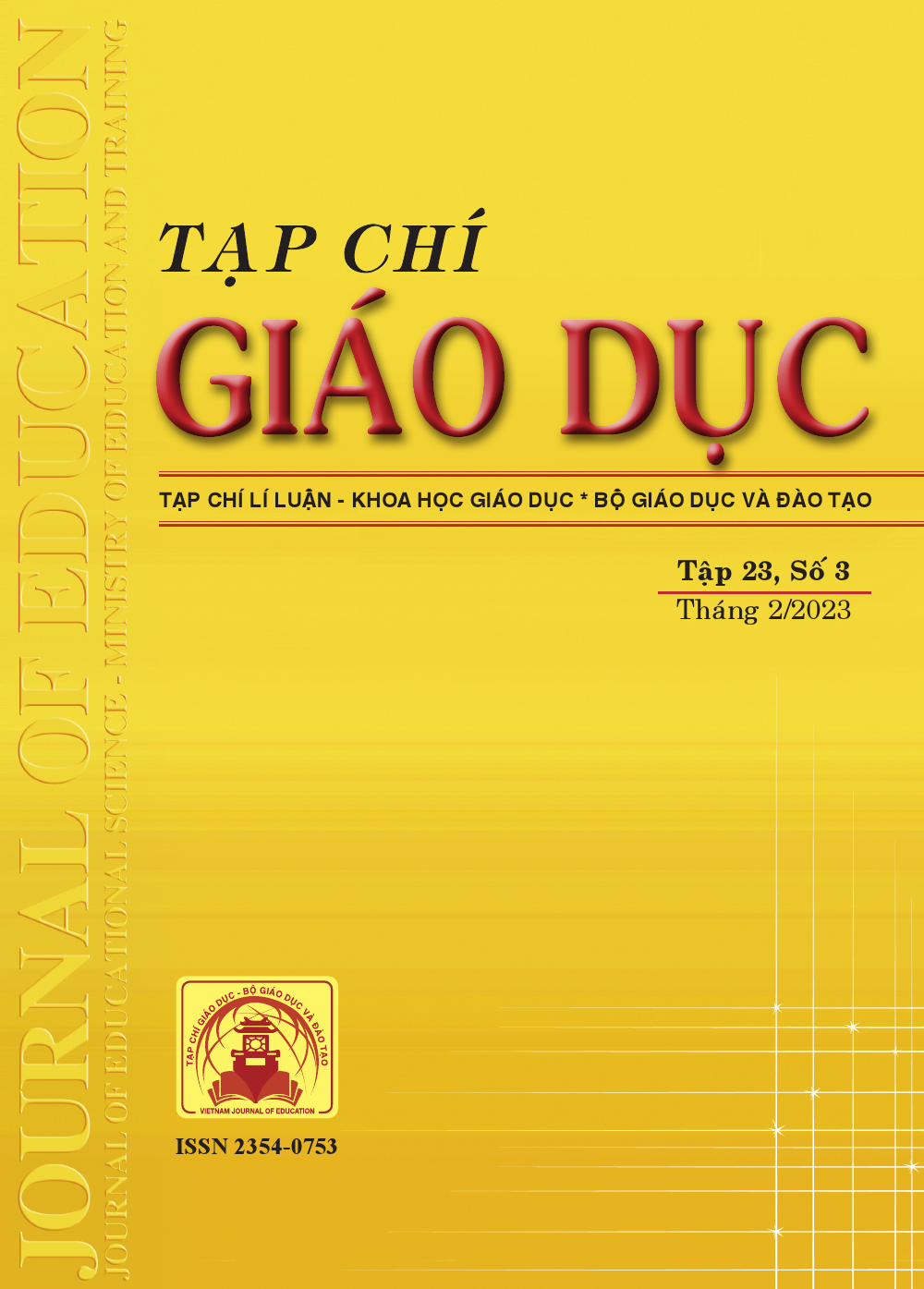Đề xuất quy trình dạy học thống kê trong môi trường lớp học đảo ngược nhằm phát triển năng lực toán cho học sinh trung học phổ thông
Tóm tắt
In the new Math curriculum, statistical content is prioritized from grade 2 to grade 12 with the aim of developing students' competencies and qualities. On the basis of synthesis and systematic analysis of documents related to teaching statistics in mathematics, the article clarifies basic knowledge about statistics, some difficulties and principles of teaching statistics. From there, we propose a flexible flipped classroom model and principles to design a flipped high school math program to develop learners' competencies and qualities. Several lessons withdrawn from the study will also be discussed.
Tài liệu tham khảo
Bakker, A. & Gravemeijer, K. P. E. (2004). Learning to reason about distributions. In The Challenge of Developing Statistical Literacy, Reasoning, and Thinking. D. Ben-Zvi and J. Garfield (Eds), 147-168. Dordrecht: Kluwer Academic.
Ben-Zvi, D. (2000). Toward understanding the role of technological tools in statistical learning. Math. Thinking Learning, 2(1&2), 127-155.
Bransford, J., Brown, A. L., & Cocking, R. R. (Eds.). (2000). How People Learn: Brain, Mind, Experience, and School. Washington, DC: National Academy Press.
Chance, B. L. (2002). Components of statistical thinking and implications for instruction and assessment. Journal of Statistics education, 10(3). https://doi.org/10.1080/10691898.2002.11910677
Chick, H. L., & Watson, J. M. (2002). Collaborative influences on emergent statistical thinking - a case study. J. Math. Beh., 21, 371-400.
Clark, J., Karuat, G., Mathews, D., & Wimbish, J. (2003). The Fundamental Theorem of Statistics: Classi-fying Student understanding of basic statistical concepts. http://www1. hollins.edu/faculty/clarkjm/stat2c.pdf
Cobb, P., McClain, K., & Gravemeijer, K. P. E. (2003). Learning about statistical covariation. Cogn. Instruct., 21(1), 1-78.
DelMas, R. C. (2002). Statistical literacy, reasoning, and learning: A commentary. Journal of Statistics Education, 10(3). https://doi.org/10.1080/10691898.2002.11910679
Gal, I. (2002). Adults’ statistical literacy: Meaning, components, responsibilities. Int. Stat.Rev., 70(1), 1-25.
Garfield, J. (1995). How students learn statistics. International Statistical Review/Revue Internationale de Statistique, 25-34. https://doi.org/10.2307/1403775
Garfield, J. (1995). How Students Learn Statistics. International Statistical Review / Revue Internationale de Statistique, 63(1), 25-34. https://doi.org/10.2307/1403775
Garfield, J., & Ben-Zvi, D. (2007). How Students Learn Statistics Revisited: A Current Review of Research on Teaching and Learning Statistics 75, 3, 372-396. https://doi.org/10.1111/j.1751-5823.2007.00029
Garfield, J., & Ben-Zvi, D. (2008). Developing Students’ Statistical Reasoning: Connecting Research and Teaching Practice. Dordrecht: Springer.
Garfield, J., & Chance, B. (2000). Assessment in Statistics Education: Issues and Challenges. Mathematical Thinking and Learning, 2(1-2), 99-125. https://doi.org/10.1207/s15327833mtl0202_5
Goodwin, B., & Miller, K. (2013). Evidence on flipped classrooms is still coming in. Educational Leadership, 70(6), 78-80.
Hancock, C., Kaput, J. J., & Goldsmith, L. T. (1992). Authentic inquiry with data: Critical barriers to classroomimplementation. Educ. Psychol., 27(3), 337-364.
He, J. (2020). Research and practice of fipped classroom teaching mode based on guidance case. Education and Information Technologies, 25, 2337-2352.
Jones, G. A., Langrall, C. W., & Mooney, E. S. (2007). Research in probability: Responding to classroom realities. In The Second Handbook of Research on Mathematics, Ed. F.K. Lester, pp. 909-956. Reston, VA: National Council of Teachers of Mathematics (NCTM).
Konold, C., & Pollatsek, A. (2002). Data analysis as the search for signals in noisy processes. J. Res. Math. Educ., 33(4), 259-289.
Lê Thị Phượng, Bùi Phương Anh (2017). Dạy học theo mô hình lớp học đảo ngược nhằm phát triển năng lực tự học cho sinh viên. Tạp chí Khoa học Quản lí giáo dục, 10, 1-8.
Magel, R. C. (1998). Using cooperative learning in a large introductory statistics class. J. Stat. Educ., 6(3). http://www.amstat.org/publications/jse/v6 n3/magel.html
Makar, K., & Confrey, J. (2005). Using distributions as statistical evidence in well-structured and ill-structured problems. In Reasoning About Distribution: A Collection of Current Research Studies. Proceedings of the Fourth International Research Forum on Statistical Reasoning, Thinking, and Literacy (SRTL-4), Ed. K. Makar, University of Auckland, New Zealand, 2-7 July. Brisbane: University of Queensland.
Meletiou, M., & Lee, C. (2002). Teaching students the stochastic nature of statistical concepts in an introductory statistics course. Stat. Educ. Res. J., 1(2), 22-37. http://www.stat.auckland. ac.nz/∼iase/serj/SERJ1(2).pdf
Mokros, J., & Russell, S. J. (1995). Children’s concepts of average and representativeness. J. Res. Math. Educ., 26, 20-39.
National Council of Teachers of Mathematics (2000). Principles and standards for school mathematics. Reston, VA: Author.
Pfannkuch, M. (2005). Probability and statistical inference: How can teachers enable learners to make the connection? In Exploring Probability in School: Challenges for Teaching and Learning, Ed. G.A. Jones, pp. 267-294. New York: Springer.
Shaughnessy, J. M. (2007). Research on statistics learning and reasoning. In The Second Handbook of Researchon Mathematics, Ed. F.K. Lester, pp. 957-1010. Reston, VA: National Council of Teachers of Mathematics (NCTM).
Song Y., & Kapur, M. (2017). How to Flip the Classroom - “Productive Failure or Traditional Flipped Classroom” Pedagogical Design? Educational Technology & Society, 292-305.
Võ Thị Thiên Nga (2019). Quy trình dạy học dự án theo mô hình “lớp học đảo ngược” cho sinh viên Khoa Sư phạm Trường Đại học Phạm Văn Đồng. Tạp chí Giáo dục, 451, 24-27.
Watson, J., & Callingham, R. (2003). Statistical literacy: A complex hierarchical construct. Statistics Education Research Journal, 2(2), 3-46. https://doi.org/10.52041/serj.v2i2.553
Tải xuống
Đã Xuất bản
Cách trích dẫn
Số
Chuyên mục
Giấy phép

Tác phẩm này được cấp phép theo Ghi nhận tác giả của Creative Commons Giấy phép quốc tế 4.0 .












